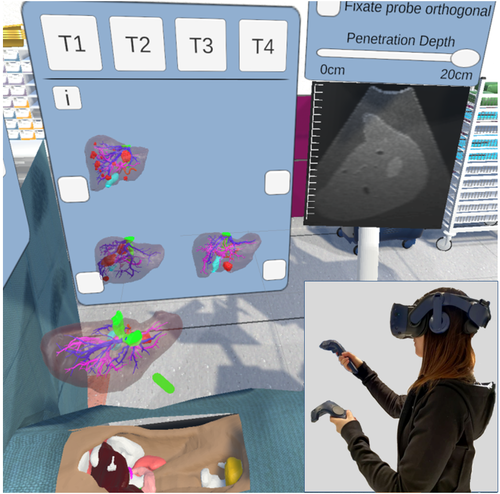NEWS
SCIENCE-INSIGHT - Virtual Reality Trainingsmethoden für medizinische Eingriffe
Eine chirurgische Ausbildung beinhaltet das Erlernen mentaler, motorischer und strategischer Fähigkeiten. Einige anatomische Zusammenhänge und chirurgische Herausforderungen, beziehungsweise den Umgang mit diesen, können nur durch learning-by-doing erlernt werden. Learning-by-doing bedeutet in der Chirurgie, dass die Fähigkeiten überwiegend direkt während medizinischer Eingriffe erlernt werden. Aus ethischen Gründen und um die Patient:innen sowie die angehenden Chirurg:innen zu schützen, sind zusätzliche Trainingsmöglichkeiten wichtig. Virtual Reality (VR) Trainingsanwendungen ermöglichen im Gegensatz zu physikalischen Simulationen eine ressourcenschonende Alternative, welche auch zusätzliche Informationen durch Visualisierungen bereitstellen kann. Relevante medizinische Eingriffe und Aspekte sowie deren Umsetzung als VR Training stellen das Forschungsgebiet von der Doktorandin Mareen Allgaier (AG Visualisierung aus der Fakultät für Informatik der Otto-von-Guericke-Universität Magdeburg sowie RG Computational Medicine – Image Processing des Forschungscampus STIMULATE) dar, welches sie in interdisziplinärer Zusammenarbeit mit folgenden Gruppen und Organisationen beforscht: AG Visualisierung (OvGU FIN), RG Human-Machine Interaction (STIMULATE HMI)/Virtual and Augmented Reality Group (OvGU FIN), RG Computational Medicine – Image Processing (STIMULATE CM-IP) sowie medizinische Kooperationspartnern der Universitätsklinik für Neurochirurgie am Universitätsklinikum Magdeburg, Universitätsklinik für Neuroradiologie am Universitätsklinikum Magdeburg und Klinik für Allgemein-, Viszeral- und Transplantationschirurgie an der Universitätsmedizin der Johannes Gutenberg-Universität Mainz.
Im Rahmen dieses Forschungsvorhabens werden einerseits technische Aspekte, wie beispielsweise die Wahl eines geeigneten Eingabegerätes, untersucht. Andererseits werden in enger Zusammenarbeit mit den Ärzt:innen geeignete medizinische Eingriffe und die zu erlernenden Fähigkeiten analysiert sowie anwendungsspezifische Anforderungen definiert. Die gewonnenen Erkenntnisse werden dann von Mareen Allgaier in den von ihr entwickelten VR Trainingsanwendungen umgesetzt.
Im Hauptprojekt adressiert sie die räumlich-visuellen Fähigkeiten, die zum Durchführen und für das Verständnis von Ultraschall notwendig sind. Die durchführenden Ärzt:innen erstellen dazu anhand des zweidimensionalen Ultraschallbildes und der Position des Ultraschallkopfes auf der zu schallenden Anatomie ein mentales dreidimensionales Modell der innenliegenden Strukturen. Im Fall von intraoperativem Leberultraschall wird der Ultraschallkopf direkt auf der offen liegenden Leber aufgesetzt, weshalb eine sichere Lernumgebung essentiell ist. In enger Kooperation mit den medizinischen Expert:innen aus Mainz wurden eine performante Ultraschallsimulation sowie verschiedene Lernszenarien definiert und entsprechend als VR Anwendung implementiert. Eine erste qualitative Auswertung zeigte, dass die Ultraschallsimulation, die virtuelle Umgebung und drei von vier Trainingsszenarien angemessen für das adressierte Lernziel sind. Hier bieten wir einen kommentierten Einblick in das VR Training.
Momentan wird im Rahmen dieses Forschungsvorhabens untersucht, wie man die beschriebene Trainingsanwendung durch Gamification – das Verwenden von Spielelementen in einem nicht-Spiel Kontext – attraktiver gestalten kann. Idealerweise führt Gamification zu einer erhöhten Motivation und Engagement, wodurch das Lernergebnis positiv beeinflusst werden kann. In Zukunft soll das qualitative Feedback sowie die Ergebnisse einer Gamification Studie in die Anwendung eingebaut werden, um dann final eine Studie bezüglich des Lernerfolges durchzuführen.

SCIENCE-INSIGHT - VIRTUAL REALITY TRAINING METHODS FOR MEDICAL PROCEDURES
Surgical training involves learning mental, motor and strategic skills. Some anatomical relationships and surgical challenges, or how to deal with them, can only be learned by learning-by-doing. In surgery, learning-by-doing means that skills are predominantly learned directly during medical procedures. For ethical reasons and to protect the patient as well as the trainee surgeon, additional training opportunities are important. Virtual reality (VR) training applications, in contrast to physical simulations, provide a resource-efficient alternative that can also provide additional information through visualizations. Relevant medical interventions and aspects as well as their implementation as VR training represent the research area of PhD student Mareen Allgaier (AG Visualisierung from the Faculty of Computer Science at Otto-von-Guericke-University Magdeburg as well as RG Computational Medicine - Image Processing of the Research Campus STIMULATE), which she is researching in interdisciplinary collaboration with the following groups and organizations: AG Visualization (OvGU FIN), RG Human-Machine Interaction (STIMULATE HMI)/Virtual and Augmented Reality Group (OvGU FIN), RG Computational Medicine - Image Processing (STIMULATE CM-IP) as well as medical cooperation partners of the Department of Neurosurgery at the University Hospital Magdeburg, the Department of Neuroradiology at the University Hospital Magdeburg and the Department of General, Visceral and Transplant Surgery at the University Medical Center of the Johannes Gutenberg University Mainz.
Within the framework of this research project, technical aspects, such as the choice of a suitable input device, are being investigated on the one hand. On the other hand, suitable medical interventions and the skills to be learned are analyzed in close cooperation with the physicians, and application-specific requirements are defined. The insights gained will then be implemented by Mareen Allgaier in the VR training applications she has developed.
In the main project, it addresses the spatial-visual skills necessary for performing and understanding ultrasound. The performing physicians create a mental three-dimensional model of the internal structures based on the two-dimensional ultrasound image and the position of the ultrasound probe on the anatomy to be scanned. In the case of intraoperative liver ultrasound, the ultrasound device is placed directly on the open liver, so a safe learning environment is essential. In close cooperation with medical experts from Mainz, a high-performance ultrasound simulation and various learning scenarios were defined and implemented as a VR application. A first qualitative evaluation showed that the ultrasound simulation, the virtual environment and three of four training scenarios are appropriate for the addressed learning goal. Here we provide an annotated insight into the VR training.
Currently, this research project is investigating how to make the described training application more attractive through gamification - the use of game elements in a non-game context. Ideally, gamification leads to increased motivation and engagement, which can positively influence the learning outcome. In the future, the qualitative feedback as well as the results of a gamification study will be integrated into the application in order to finally conduct a study regarding the learning success.